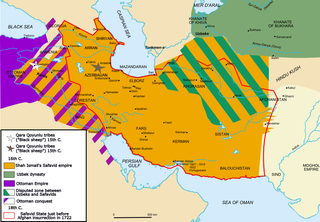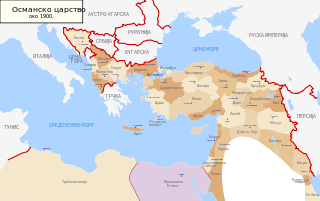Related Research Articles

Murad IV was the sultan of the Ottoman Empire from 1623 to 1640, known both for restoring the authority of the state and for the brutality of his methods. Murad IV was born in Constantinople, the son of Sultan Ahmed I and Kösem Sultan. He was brought to power by a palace conspiracy when he was just 11 years old, and he succeeded his uncle Mustafa I. Until he assumed absolute power on 18 May 1632, the empire was ruled by his mother, Kösem Sultan, as nāʾib-i salṭanat (regent). His reign is most notable for the Ottoman–Safavid War, of which the outcome would partition the Caucasus between the two Imperial powers for around two centuries, while it also roughly laid the foundation for the current Turkey–Iran–Iraq borders.

The Ottoman Empire, historically and colloquially known as the Turkish Empire, was an empire that controlled much of Southeast Europe, Western Asia, and Northern Africa between the 14th and early 20th centuries. The empire also controlled an eastern region of Central Europe from the 16th to the late 17th century.

Osman I or Osman Ghazi, sometimes transliterated archaically as Othman, was the founder of the Ottoman Empire. While initially a small Turkoman principality during Osman's lifetime, his beylik transformed into a world empire in the centuries after his death. It existed until shortly after the end of World War I.

Ertuğrul or Ertuğrul Gazi was a 13th-century bey, who was the father of Osman I. Little is known about Ertuğrul's life. According to Ottoman tradition, he was the son of Suleyman Shah, the leader of the Kayı tribe of the Oghuz Turks. These Turkomans fled from western Central Asia to Anatolia to escape the Mongol conquests, but he may instead have been the son of Gündüz Alp. According to this legend, after the death of his father, Ertuğrul and his followers entered the service of the Sultanate of Rum, for which he was rewarded with dominion over the town of Söğüt on the frontier with the Byzantine Empire. This set off the chain of events that would ultimately lead to the founding of the Ottoman Empire.

The Ottoman Interregnum, or the Ottoman Civil War, was a civil war in the Ottoman Empire between the sons of Sultan Bayezid I following the defeat of their father at the Battle of Ankara on 20 July 1402. Although Mehmed Çelebi was confirmed as sultan by Timur, his brothers İsa Çelebi, Musa Çelebi, Süleyman Çelebi, and later, Mustafa Çelebi, refused to recognize his authority, each claiming the throne for himself. Civil war was the result. The Interregnum lasted a little under 11 years, until the Battle of Çamurlu on 5 July 1413, when Mehmed Çelebi emerged as victor, crowned himself Sultan Mehmed I, and restored the empire.

The historiography of the Ottoman Empire refers to the studies, sources, critical methods and interpretations used by scholars to develop a history of the Ottoman Dynasty's empire.
This article gives an overview of liberalism in Turkey. Liberalism was introduced in the Ottoman Empire during the Tanzimat period of reformation.

The caliphate of the Ottoman Empire was the claim of the heads of the Turkish Ottoman dynasty to be the caliphs of Islam in the late medieval and early modern era. During the period of Ottoman expansion, Ottoman rulers claimed caliphal authority after the conquest of Mamluk Egypt by sultan Selim I in 1517, which bestowed the title of Defender of the Holy Cities of Mecca and Medina upon him and strengthened the Ottoman claim to caliphate in the Muslim world.

The history of the Ottoman Empire in the 18th century has classically been described as one of stagnation and reform. In analogy with 18th-century France, it is also known as the Ancien Régime or Old Regime, contrasting with the "New Regime" of the Nizam-i Cedid and Tanzimat in the 19th century.

Süleyman Pasha was the son of Orhan, the second ruler of the newly established Ottoman Empire. He played a major role in early Ottoman expansion into Thrace in the 1350s. He died in a hunting accident in 1357.
Lala Şahin Pasha, 1330 – 1388(?), was an Ottoman commander and first Beylerbey of Rumelia. He was the teacher (lala) of Sultan Murad I, and when Murad succeeded the throne, Şahin led the Ottoman campaign of Thrace. In 1360, he took Didymoticho, and in 1362, Adrianople, which afterwards served as the Ottoman seat of throne as Edirne. In 1364, conquered Boruj and Plovdiv in Bulgaria. He was one of commanders in Battle of Maritsa (1371). From 1383 to 1385 he ruled as the Ottoman governor in Sofia. He was defeated by Prince Lazar of Serbia at the Battle of Pločnik (1385–86). On 27 August 1388 he was defeated by an alliance of Bosnian princes at the Battle of Bileća. Lala Shahin probably died in 1389 in Kazanlak, Bulgaria has an old mausoleum /turbe/ in park "Tulbeto", near the famous Thracian Tomb of Kazanlak. Later the remains of Lala Shahin was removed from Kazanlak tomb to another one in his homeland, Mustafakemalpaşa district in the province of Bursa, Turkey.

The Köprülü era was a period in which the Ottoman Empire's politics were frequently dominated by a series of grand viziers from the Köprülü family. The Köprülü era is sometimes more narrowly defined as the period from 1656 to 1683, as it was during those years that members of the family held the office of grand vizier uninterruptedly, while for the remainder of the period they occupied it only sporadically.

The Ottoman–Safavid War of 1623–1639 was the last of a series of conflicts fought between the Ottoman Empire and Safavid Iran, then the two major powers of Western Asia, over control of Mesopotamia. After initial Persian success in recapturing Baghdad and most of modern Iraq, having lost it for 90 years, the war became a stalemate as the Persians were unable to press further into the Ottoman Empire, and the Ottomans themselves were distracted by wars in Europe and weakened by internal turmoil. Eventually, the Ottomans were able to recover Baghdad, taking heavy losses in the final siege, and the signing of the Treaty of Zuhab ended the war in an Ottoman victory. Roughly speaking, the treaty restored the borders of 1555, with the Safavids keeping Daghestan, Shirvan, eastern Georgia, and Eastern Armenia, while western Georgia and Western Armenia decisively came under Ottoman rule. The eastern part of Samtskhe (Meskheti) was irrevocably lost to the Ottomans as well as Mesopotamia. Although parts of Mesopotamia were briefly retaken by the Iranians later on in history, notably during the reigns of Nader Shah (1736–1747) and Karim Khan Zand (1751–1779), it remained thenceforth in Ottoman hands until the aftermath of World War I.
Hadım Ali Pasha, also known as Atik Ali Pasha, was an Ottoman statesman and eunuch of Bosnian origin. He served as governor of Rumeli, and led the Ottoman army in the Ottoman–Mamluk War of 1485–1491, but was defeated at Adana in 1488. He was then named Grand Vizier from 1501 to 1503, and again from 1509 to 1511. During his latter tenure, he led the suppression of the Alevi-led Şahkulu Rebellion, but died in battle near Sivas along with the rebel leader Şahkulu himself.
Şahkulu, also known as Şahkulu Baba, or Karabıyıkoğlu, was the leader of the pro-Shia and pro-Safavid uprising in Anatolia – the Şahkulu Rebellion – directed against the Ottoman Empire in 1511. He was viewed as a Messiah and Prophet by his followers. His death in battle signified the end of the uprising.

This is a bibliography of notable works about the Ottoman Empire.
Abaza Hasan Pasha, also called Kara Hasan Pasha or Celali Hasan Pasha;, was an Ottoman provincial governor and celali rebel of the mid-seventeenth century. He launched two rebellions against the Ottoman government, the second and largest of which ended with his assassination in Aleppo on 16 February 1659 following a failed attempt to force the deposition of the Grand Vizier Köprülü Mehmed Pasha.

The Transformation of the Ottoman Empire, also known as the Era of Transformation, constitutes a period in the history of the Ottoman Empire from c. 1550 to c. 1700, spanning roughly from the end of the reign of Suleiman the Magnificent to the Treaty of Karlowitz at the conclusion of the War of the Holy League. This period was characterized by numerous dramatic political, social, and economic changes, which resulted in the empire shifting from an expansionist, patrimonial state into a bureaucratic empire based on an ideology of upholding justice and acting as the protector of Sunni Islam. These changes were in large part prompted by a series of political and economic crises in the late 16th and early 17th centuries, resulting from inflation, warfare, and political factionalism. Yet despite these crises the empire remained strong both politically and economically, and continued to adapt to the challenges of a changing world. The 17th century was once characterized as a period of decline for the Ottomans, but since the 1980s historians of the Ottoman Empire have increasingly rejected that characterization, identifying it instead as a period of crisis, adaptation, and transformation.

The Ghaza or Ghazi thesis is a historical paradigm first formulated by Paul Wittek which has been used to interpret the nature of the Ottoman Empire during the earliest period of its history, the fourteenth century, and its subsequent history. The thesis addresses the question of how the Ottomans were able to expand from a small principality on the frontier of the Byzantine Empire into a centralized, intercontinental empire. According to the Ghaza thesis, the Ottomans accomplished this by attracting recruits to fight for them in the name of Islamic holy war against the non-believers. Such a warrior was known in Ottoman Turkish as a ghazi, and thus this thesis sees the early Ottoman state as a "Ghazi State," defined by an ideology of holy war. The Ghaza Thesis dominated early Ottoman historiography throughout much of the twentieth century before coming under increasing criticism beginning in the 1980s. Historians now generally reject the Ghaza Thesis, and consequently the idea that Ottoman expansion was primarily fueled by holy war, but disagree about what hypothesis to replace it with.
Alan Mikhail is an American historian who is a professor of history at Yale University. His work centers on the history of the Ottoman Empire.
References
- ↑ "How the Ottomans shaped London". BBC. 14 June 2010. Retrieved 11 January 2021.
- ↑ Imber, Colin (2006). "Review of Osman's Dream: The Story of the Ottoman Empire, 1300-1923". Bulletin of the School of Oriental and African Studies, University of London. 69 (2): 317–319. doi:10.1017/S0041977X06220147. ISSN 0041-977X. JSTOR 20182042. S2CID 162933983.
- ↑ "Aksan on Finkel, 'Osman's Dream: The Story of the Ottoman Empire, 1300-1923' | H-Turk | H-Net". networks.h-net.org. Retrieved 11 January 2021.
- ↑ "Buying the Guide Book". www.cultureroutesinturkey.com. Archived from the original on 23 January 2012.